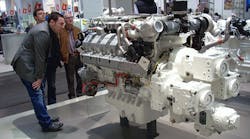It’s pretty obvious why companies exhibit at trade shows: to obtain leads from new and existing customers, ultimately leading to increased sales. Trade shows are a gamble for exhibitors, but the payoff can be huge, even if they don’t come away with many leads.
I don’t know all the expenses incurred in exhibiting at a trade show, or the magnitude of the costs. So for sake of discussion, let’s say it costs a small company about $60,000 to exhibit. I’m guessing only about half that would account for the cost of the booth, shipping and setup fees, and travel costs for personnel, with the rest going to other expenses.
People working the booth hope for a steady stream of visitors, generating dozens of good leads. In reality, most trade shows go through long periods with no one visiting the booth or even strolling down the aisle. So the question is, how many good leads should you expect?
Let’s say you expect about 25 visitors a day. This number depends on many variables—especially the number of people attending the show, how interested they are in the products or services you’re offering, and how effective your booth and personnel are at attracting visitors. So if 25 visitors sounds too high or too low, adjust up or down.
If this is a three-day show, let’s say you come away with 50 leads. I’m trying to be conservative here. Further, let’s say one-fourth are good leads, which puts us at 12. And of these 12 good leads, let’s say three lead to a sale. So a $60,000 investment yielding three new customers may not sound like a wise investment—at first.
To determine how good an investment this is, consider how much money your average customer spends with you a year, and how many years you retain the average customer. If the average customer spends $50,000 a year, and your average customer lasts only three years, then those three sales resulting from the show correspond to $450,000. From this perspective, exhibiting at the right trade show sounds like a wise investment.
But what about those who attend trade shows? As a reader of H&P, you probably go to trade shows to expand your knowledge of what’s available in fluid power. Sometimes you learn about offerings from companies you weren’t familiar with, and sometimes you discover important products from companies you’ve dealt with for years.
That’s exactly what happened when I visited the booth of a company at Waste Expo. I’ve known the company for more than 30 years as one of the top suppliers of pneumatic products. I’m familiar with their air cylinders, valves, F-R-Ls, fittings, and other products used in a variety of industrial applications and factory automation. What I didn’t know was that they also have a line of products for trucks, trailers, and other over-the-road vehicles.
The surprise here was learning how different the components are for this market. The rep at the booth explained that designers familiar with industrial pneumatics sometimes need to rethink their process when dealing with over-the-road vehicles. For example, he said that many products for pneumatics in this market are multi-functional. A single standard component may incorporate multiple valves, filters, and even its own pressure regulator.
He recalled how more than once he encountered designers building the circuits they needed using modular components typically used for industrial pneumatic systems. He then showed them how they could replace as many as five separate components (even more if you count connectors) using a single integrated component.
This comes back to a familiar theme: education. Just about anyone you talk with in the fluid power community knows how important education and training are. And just when you feel comfortable working in a particular sector, you never know when some little nuance you picked by being inquisitive may help you come up with an unconventional solution to a challenge.


